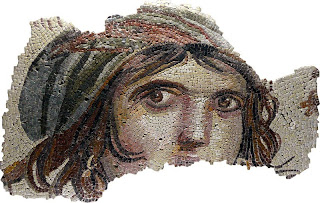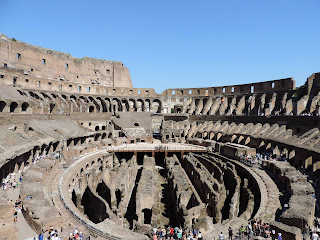Today we spent the day mainly with Andreina Nardi, Roberto's wife and well known consevator. She first took us through the traditional Roman process of making lime mortar. To begin, blocks of limestone and arranged into a large kiln, also made from limestone, and a fire is lit at the base of the kiln. The following reaction takes place: calcium carbonate plus heat yields calcium oxide (quick lime, which is very reative with water) plus carbon dioxide. The smoke from the kiln turns black when the temperature reaches roughly 700 C, and the kiln is sealed off for three to four days, until the smoke turns back to white.
After allowing a week for the kiln to cool off, the stone is removed and water is added along the following reaction: calcium oxide plus water yields calcium hydroxide. The stone must sit in the water for about three months; if the correct proportion of water is added, hydraulic lime is produced, but with extra water slaked lime (also called lime putty) is produced. Filler is then added, often sand but sometimes shell, pumice, straw, or coal, depending on what the mortar will be used for. Finally, the mortar is applied and pigments must then also be applied while the mortar is still fresh.
Andreina then taught us a little about tratteggio, a form of inpainting areas of loss in paintings and painted surfaces, and showed us incredible examples of her own use of the technique. We then spent some time working on our Medusa mosaic and working on selecting pictures, videos, and music for the final video of our time here in Italy.
Art Conservation in Italy
Saturday, June 29, 2013
Thursday June 27th
Today was our first day back at the convent and not traveling. We were excited to not have to wake up early and just be at the convent in Belmonte all day. After breakfast, we spent the next several hours reconnecting with Roberto-discussing our museum and laboratory visits in Rome as well as our days spent with Roberto Cassio and Gael de Guichen. Following a large lunch, we went back to the classroom. Roberto then showed us a series of videos from past CCA projects to give us an even better idea of the excavation of mosaics and wall murals and the issues associated with such processes.
We focused especially on Roberto Nardi's work on the ancient Roman town of Zeugma, in modern day Gaziantep,Turkey, and the breathtaking floor mosaics found there. The Euphrates River running next to the town was dammed in 2000 and the water level was raising significantly every day, meaning the ruins of Zeugma were under water within a few short months. Roberto assemled a team of all of the mosaic conservation specialists in the world at the time in record speed and they lifted the most unique mosaics before the site was covered with water. They also backfilled the numerous remaining mosaics in order to protect them from the mechanical damage of the river current. The mosaics they lifted, many of them quite massive floor mosaics, are now housed in the Zeugma Mosaic Museum in Gaziantep, Turkey, making it the largest mosaic museum in the world.
We focused especially on Roberto Nardi's work on the ancient Roman town of Zeugma, in modern day Gaziantep,Turkey, and the breathtaking floor mosaics found there. The Euphrates River running next to the town was dammed in 2000 and the water level was raising significantly every day, meaning the ruins of Zeugma were under water within a few short months. Roberto assemled a team of all of the mosaic conservation specialists in the world at the time in record speed and they lifted the most unique mosaics before the site was covered with water. They also backfilled the numerous remaining mosaics in order to protect them from the mechanical damage of the river current. The mosaics they lifted, many of them quite massive floor mosaics, are now housed in the Zeugma Mosaic Museum in Gaziantep, Turkey, making it the largest mosaic museum in the world.
Friday, June 28, 2013
Wednesday June 26th
Today we took another trip into Rome to visit the Vatican conservation labs and the Museo Vaticani. We visited three different conservation labs: the stone lab, the paintings lab, and the mosaics lab. We listened to presentations from staff of the labs with the help of our knowledgeable tour guide and translator, Giovanni.
After a quick lunch, we entered the Museo Vaticani. It was very packed inside, so we unfortunately did not have much time to admire all the beautiful artwork. Despite the time constraints, though, we managed to catch a glimpse of some famous pieces that we studied in school. After walking the length of the museum, we got to see the Sistene Chapel - definitely a life-changing experience. After exiting the museum, we explored the St. Peter's Basilica and saw some beautiful architecture and art.
Thursday, June 27, 2013
Tuesday June 25th
Today we toured the Instituto Superiore per la Conservazione ed il Restauro (ICR). Talking with conservators about the program, they explained entrance tests including the following: a drawing test, complete reproduction, reproduction of material, color test, and fills. The program lasts for 5 years with one free month in August. Classes are 6 days a week and are further divided into two parts, 3 days for practical work and 3 days for more theory oriented material (general chemistry and history subjects). We were all amazed at the beautiful conservation labs and program.
After touring ICR, we visited the Capitoline Museum, seeing sculptures such as the bronze she wolf with Romulus and Remus and the bronze Marcus Aurelius on his horse. We then returned to the convent for one of the best dinners of our lives, begining with truffle bruschetta (made even more amazing by the fact that none of us could have afforded it at a restaurant back home!), and followed by the main meal of hand-made pizza by the fabulous cook at the convent, Maria. And lastly, Prosecco and a chocolate and pear vanilla cake because it was one of our birthdays.
After touring ICR, we visited the Capitoline Museum, seeing sculptures such as the bronze she wolf with Romulus and Remus and the bronze Marcus Aurelius on his horse. We then returned to the convent for one of the best dinners of our lives, begining with truffle bruschetta (made even more amazing by the fact that none of us could have afforded it at a restaurant back home!), and followed by the main meal of hand-made pizza by the fabulous cook at the convent, Maria. And lastly, Prosecco and a chocolate and pear vanilla cake because it was one of our birthdays.
Monday June 24th
Today we woke up early to drive to Assisi, getting more and more excited as the scenery became increasingly beautiful the closer we got to the city. We enjoyed a walk through the city along the cobblestoned winding streets, up and down the hills. Our first stop was the Basilica of Saint Francis of Assisi, where we spent hours in awe of the painted wall murals of both the upper annd the lower churches.
Next, we visited the Curch of Saint Claire, and then ran through the rain to get back to the cars to head off to Spoleto. In Spoleto we went to the Duoma Sant'Imbria Assunti and then walked along a Roman aqueduct and were greeted by a breathtaking view of the valley and surrounding cliffs.
Next, we visited the Curch of Saint Claire, and then ran through the rain to get back to the cars to head off to Spoleto. In Spoleto we went to the Duoma Sant'Imbria Assunti and then walked along a Roman aqueduct and were greeted by a breathtaking view of the valley and surrounding cliffs.
Sunday June 23rd
Today we visited the Foro Romano, the Colosseo, and the Museo Nazionale, so just about as much of Rome as one can see in a day! The fantastic art historian, Giovanni Ferni, met us at our hotel bright and early to try to beat the heat at the Forum. It was amazing to see so many layers of Roman history represented in the center of a bustling metropolis. We discussed the traditional uses of the basilica as both places of public trial, and areas for the gathering of Romans to discuss business.
After lunch, it was off to the Colosseo, which is a truly amazing place. The Colosseo was built on what was once an artificial lake, in order to return the space to the people of Rome. Although what is left of the Colosseo is basically just it's skeleton, one can image the grandeur of what once was a marble covered, heavily decorated public space with statues in all of the arches.
We spent the remainder of the afternoon at the Museo Nazionale looking at mosaics, wall paintings, and marble sculptures. The museum was a nice change of pace from the heat, and seeing mosaics similar to our medusa was a blast! A day so packed of knowledge and images to absorb made for a pretty tired group, but we are excited for our trek back into Rome on Tuesday.
After lunch, it was off to the Colosseo, which is a truly amazing place. The Colosseo was built on what was once an artificial lake, in order to return the space to the people of Rome. Although what is left of the Colosseo is basically just it's skeleton, one can image the grandeur of what once was a marble covered, heavily decorated public space with statues in all of the arches.
We spent the remainder of the afternoon at the Museo Nazionale looking at mosaics, wall paintings, and marble sculptures. The museum was a nice change of pace from the heat, and seeing mosaics similar to our medusa was a blast! A day so packed of knowledge and images to absorb made for a pretty tired group, but we are excited for our trek back into Rome on Tuesday.
Tuesday, June 25, 2013
Saturday June 22nd
Today was our first day in Rome! After quick cappuccinos at a local bar, we went to Peter Rockwell's, sculptor and son of Norman Rockwell, studio. He started the day by giving a brief lecture on ancient carving tools and techniques.
We then went to do our own carving in both soft and hard stones.
Taking a quick break for lunch in the park and a gelato, we got back to work. We definitely gained a new respect for master sculptors.
At the end of the day, being thoroughly coated in dust, we took a walk from the studio to the hotel. We went to Gael de Guichen's apartment for appetizers and conversation before having a pizza dinner and spending the night in Trastevere.
We then went to do our own carving in both soft and hard stones.
Taking a quick break for lunch in the park and a gelato, we got back to work. We definitely gained a new respect for master sculptors.
At the end of the day, being thoroughly coated in dust, we took a walk from the studio to the hotel. We went to Gael de Guichen's apartment for appetizers and conversation before having a pizza dinner and spending the night in Trastevere.
Subscribe to:
Comments (Atom)













